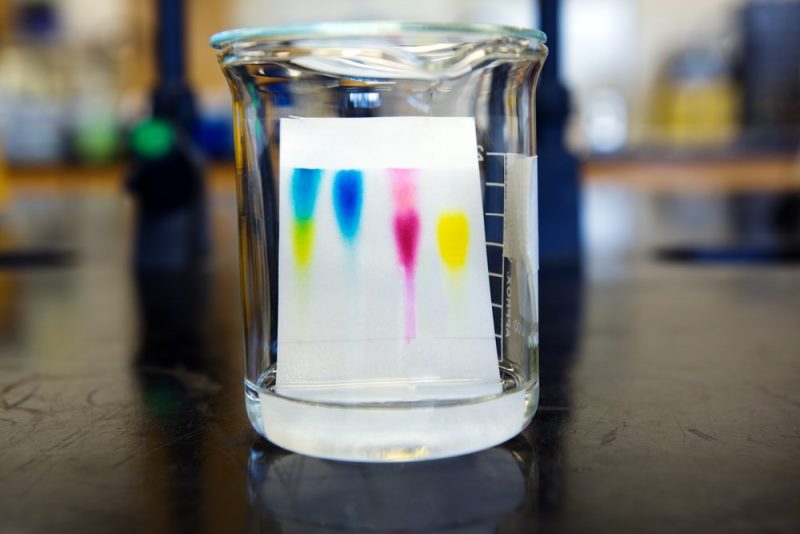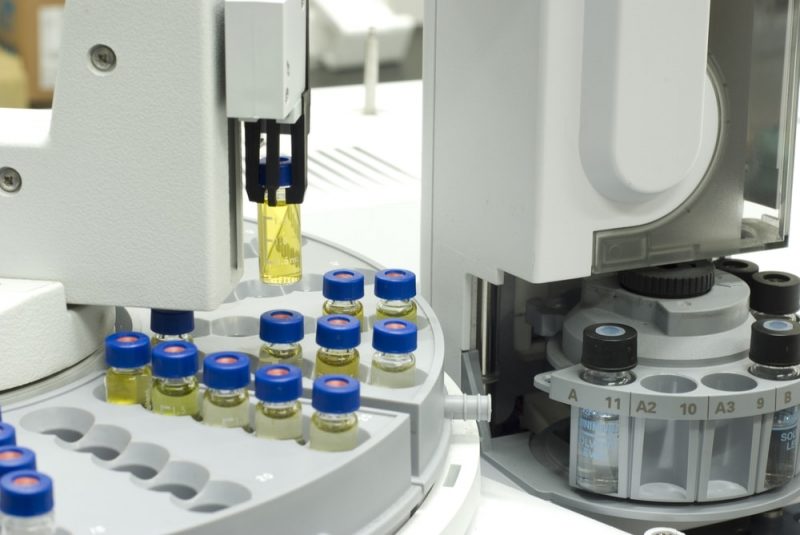The chromatography is a method of separation of complex mixtures widely used in different branches of science. It uses a set of techniques based on the principle of selective retention to separate the components of a mixture in a high state of purity, or to identify them in a mixture and determine their proportions. For instance: to review crime scenes, in a urine test, to separate inks.
The chromatographic method It consists of the separation of the components of a mixture using the different affinity of each one for a stationary phase and a mobile phase. The substance to be separated is called an analyte. Both phases can be described as:
- Stationary phase. It is a substance that remains immobile during chromatography. It can be fixed inside a column of glass, stainless steel or other material, as well as it can be attached to a support. This phase can be paper or a resin, among other substances.
- Mobile phase. It is a substance that moves in a certain direction and direction through the stationary phase. It can be liquid or fizzy. Examples of this phase can be hexane, a water / methanol mixture, among other substances.
The method then works by injecting the sample (mixture of substances to be separated) into the mobile phase. Then the mobile phase (with the sample) passes through the stationary phase and the components are separated according to how related they are to one phase or the other. If we have a two-component sample, for example, the more related component of the stationary phase will separate from it after the less related component, which will be moving with the mobile phase.
The selectivity of each component by both phases depends on the properties of the components and the phases (the polarity of each one, the size of the pores of the stationary phase in case of being solid or a resin, the electrochemical properties, among others).
Once the components of the mixture have been separated, they pass through some type of detector that can be used to identify them and to measure their concentration or some property that represents a measure of their quantity in the sample. The detectorsDepending on their type, they can measure some physical property of the component of interest, such as its color, its refractive index, its electrical conductivity, among others.

Chromatography examples
- Spilling wine on a white tablecloth. When the wine dries in contact with the air, the various substances that compose it will dye the white of the fabric a different color.
- In blood tests. Chromatography of blood samples is often carried out to be able to separate and identify substances contained in it, normally imperceptible, from the color that they reflect on a support or subjected to a specific light. Such is the case of a drug or a specific substance, such as alcohol.
- In a urine test. Urine, even more than blood, is a mixture of various compounds, the presence or absence of which reveals how the body works. Hence, a chromatographic separation can be performed to look for unusual residues, such as blood, salts, glucose, or drugs.
- To review crime scenes. As in films, fabrics, fibers, fabrics or other supports are taken to observe the separation by adherence of different substances, such as semen or blood, which at first glance could go unnoticed.
- To do food health checks. Since the reaction of foods when subjected to a chromatographic spectrum is known, it can be observed if there is some type of improper substance or product of microbial agents in them from a small sample.
- To check contamination levels. Either in air or water, the reaction of dissolved and imperceptible substances can be measured from a small sample, using a specific support that allows one to distinguish between the compounds, allowing the water to dry, for example.
- Complex microbiology tests. This technique is widely used to combat diseases such as Ebola, for example because it allows the distinction between the most and least effective antibodies in the face of the disease.
- For petrochemical applications. Chromatography is useful in the process of separating hydrocarbons from petroleum and transforming them into various refined materials, which have highly dissimilar and observable properties and adhesions.
- For fire checking. To determine whether or not they were provoked, a chromatography of the residues is often used, to show the presence of unexpected substances whose reactivity is different from those of the rest, such as certain fossil fuels.
- To separate inks. Since inks are composed of various pigments in a liquid medium, it is possible to separate these pigments by chromatography and reveal the differences between each one.
- To detect radioactivity. Since radioactive elements have different activities and lifetimes than ordinary matter, they can often be identified using this technique in the laboratory.
- To determine the purity of a substance. In industry, high purity materials are often required, especially gases (whose volatility makes it difficult) and a mechanism to evaluate it is the detection by chromatography of residues of other substances, from the use of a static liquid phase and a phase soda mobile.
- Wine study. In the detection of monovarietal wines, chromatography is often used to find out if they are mixed with other strains, which will present different detectable characteristics in the presence of a different static medium.
- To control the industrial distillation of spirits. Through gas chromatography, the quality basic components present in the liquor (ethanol, methanol, acetaldehyde, acetal, etc.) can be identified and quantified, which allows responsible administration of these compounds.
- To make quality studies of olive oils. Chromatography is essential in the review and classification of olive oil, since it provides a study of the fat profile, acidity and peroxide value present in the mixture.

